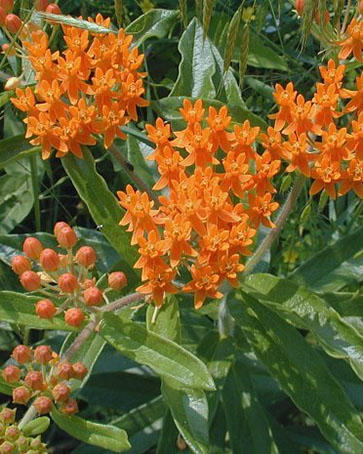Butterfly Weed
 Asclepias tuberosa
Asclepias tuberosa
Don’t let the word ”weed” scare you, butterfly weed is a bright showy flower that is most often a distinctive bright orange.
See All Native Plants for Sale
Introduction
Butterfly Weed can be found at Gabis Arboretum in the Adventure Garden and the Native Plant Garden circle. There can be some variation in flower color, from deep red-orange to yellow.
The Butterfly Weed plant has been known to attract Monarch caterpillars and a variety of butterflies enjoy the blooms. This distinctive color and the absence of the typical milky white sap that other Milkweed species have make identification easy. The leaves are somewhat narrow, up to 1” and tapered, with no stem and dark green in color.
Life Cycle
Perennial
Sun Exposure
Full, Partial
Soil Moisture
Medium, Medium-Dry, Dry
Height
2 Feet
Bloom Time
June, July, August
Bloom Color
Orange
About the Plant
This is a great Milkweed for a sunny location in a dry area. Mature plants in ideal locations can make as many as 20 stems at an average height of 2’. The vivid orange color, low mounded profile, and ability to attract and sustain butterflies make this plant a well-known landscape favorite for all types of gardens. Like all species in the Asclepias genus, Asclepias tuberosa is one of the larval host plants for the monarch butterfly.
Butterfly Weed needs a drier, well-drained location to successfully seed into and grow well. In older plants the long tap root can extend down many feet. Due to this deep, drought-tolerant tap root, it can be late to emerge in the spring, especially in northern climates, so be patient. Butterfly Weed can be transplanted if dug carefully during dormancy but if the tap root breaks off, they will regrow.
The flower nectar attracts honeybees, digger bees (Melissodes spp.), leaf-cutting bees (Megachile spp.), Halictid bees (including green metallic bees), thread-waisted wasps (Ammophila spp.) and other Sphecid wasps, and butterflies, including Fritillaries (Speyeria spp.), Swallowtails (Papilio spp.), and the Monarch (Danaus plexippus). The Ruby-throated Hummingbird is also attracted to the flowers.
Some insects feed destructively on the leaves, flowers and buds, seedpods, and other parts of Butterfly Milkweed. These insects include larvae of the Blackened Milkweed Beetle (Tetraopes melanurus), the Small Milkweed Bug (Lygaeus kalmii), the Large Milkweed Bug (Oncopeltus fasciatus), larvae of a butterfly, the Monarch (Danaus plexippus), and larvae of a moth, the Unexpected Cycnia (Cycnia inopinatus).